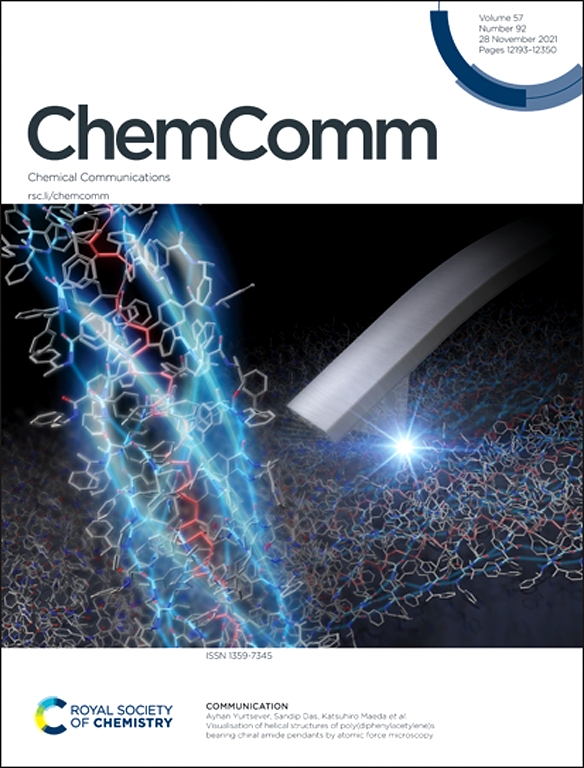通过C-Ag+ c结构对dna - agnc进行二聚化,用于双输出信号的荧光传感
IF 4.2
2区 化学
Q2 CHEMISTRY, MULTIDISCIPLINARY
引用次数: 0
摘要
Ag+独特的插入胞嘧啶-胞嘧啶(C-Ag+-C)错配碱基对的能力,使得通过改变DNA序列来精确制造DNA捕获银纳米团簇(DNA- agnc),从而提供DNA- agnc的精确组装,并展示了巨大的荧光应用。然而,大多数基于dna - agncs的荧光传感器具有单一输出信号。在此,我们通过设计的DNA的3'端C-Ag+-C连接开发了二聚化DNA- agnc系统。C-Ag+-C的形成和裂解使dna - agnc能够通过双输出信号识别Ag+和半胱氨酸(Cys),通过光诱导电子转移(PET)分别改变荧光强度(FI)和近红外发射波长移(约815 nm)。结果表明,FI对Cys和Ag+浓度具有良好的线性关系。同时,在牛奶和湖水中也成功验证了该平台的实用性。本文章由计算机程序翻译,如有差异,请以英文原文为准。

Dimerizing DNA-AgNCs via a C–Ag+–C structure for fluorescence sensing with dual-output signals†
The unique insertion capability of Ag+ into cytosine–cytosine (C–Ag+–C) mismatch-base pairs enables precise fabrication of DNA-trapped silver nanoclusters (DNA-AgNCs) through varying the DNA sequences, thereby offering precise assembly of DNA-AgNCs and demonstrating great fluorescence applications. However, most of the DNA-AgNC-based fluorescence sensors have a single output signal. Herein, we developed a dimerized DNA-AgNC system through C–Ag+–C connection at the 3′-end of a designed DNA. The formation and crack-up of C–Ag+–C endows DNA-AgNCs with the ability to identify Ag+ and cysteine (Cys) with dual-output signals, changed fluorescence intensity (FI) and wavelength-shift in NIR emission around 815 nm via photoinduced electron transfer (PET), respectively. Superior linearity of FI for Cys and Ag+ concentrations was demonstrated. Meanwhile, the practical utility of this platform was also successfully verified in milk and lake water.
求助全文
通过发布文献求助,成功后即可免费获取论文全文。
去求助
来源期刊

Chemical Communications
化学-化学综合
CiteScore
8.60
自引率
4.10%
发文量
2705
审稿时长
1.4 months
期刊介绍:
ChemComm (Chemical Communications) is renowned as the fastest publisher of articles providing information on new avenues of research, drawn from all the world''s major areas of chemical research.
 求助内容:
求助内容: 应助结果提醒方式:
应助结果提醒方式:


